The mining and energy sector has played a long and important role in the Mountain States’ economies. With large amounts of a variety of natural resources including oil, natural gas, coal, uranium, molybdenum and many others, the energy and mining sector is a key contributor to employment, earnings, gross domestic product and tax revenue in Colorado, New Mexico and Wyoming.
However, the energy sector can also be volatile, creating fluctuations in the performance of the Mountain States’ economies. Because of this volatility, Colorado, New Mexico and Wyoming in recent decades have attempted to diversify their economies.
This issue of The Rocky Mountain Economist examines the current reliance of the Mountain States’ economies on the energy sector and compares today’s activity with peak levels in the early 1980s.i
The Energy Sector Today
The energy and mining sector is a key industry in the Mountain States. In 2013, the sector made up about 6.7 percent of state gross domestic product (GDP) in Colorado, 9.8 percent in New Mexico and 37.2 percent in Wyoming. These states contribute heavily to total energy production in the United States, and in turn, energy production boosts employment, personal earnings and tax revenues in the Mountain States.
In Colorado, almost 1.3 percent of total employment and 4.4 percent of total personal earnings in 2013 were directly tied to the energy industry. Rio Blanco, Cheyenne and Moffat counties are especially reliant on the energy sector with more than 10 percent of workers employed directly in this sector (Map 1). Denver County has the state’s largest number of employees in the energy sector at 8,219; however, this only makes up 1.9 percent of total employment in Denver County. Across Colorado, oil production has more than tripled in 10 years and in 2013 contributed 2.4 percent of total U.S. production. Colorado also produces large amounts of natural gas and coal. Colorado supplied 6.3 percent of total U.S. production of marketed natural gas in 2013 and was ranked sixth nationally for production. Similarly, coal production in Colorado in 2013 made up 2.4 percent of total U.S. production and was No. 11 nationally. Colorado also produces large quantities of molybdenum and is one of the top producing states.ii
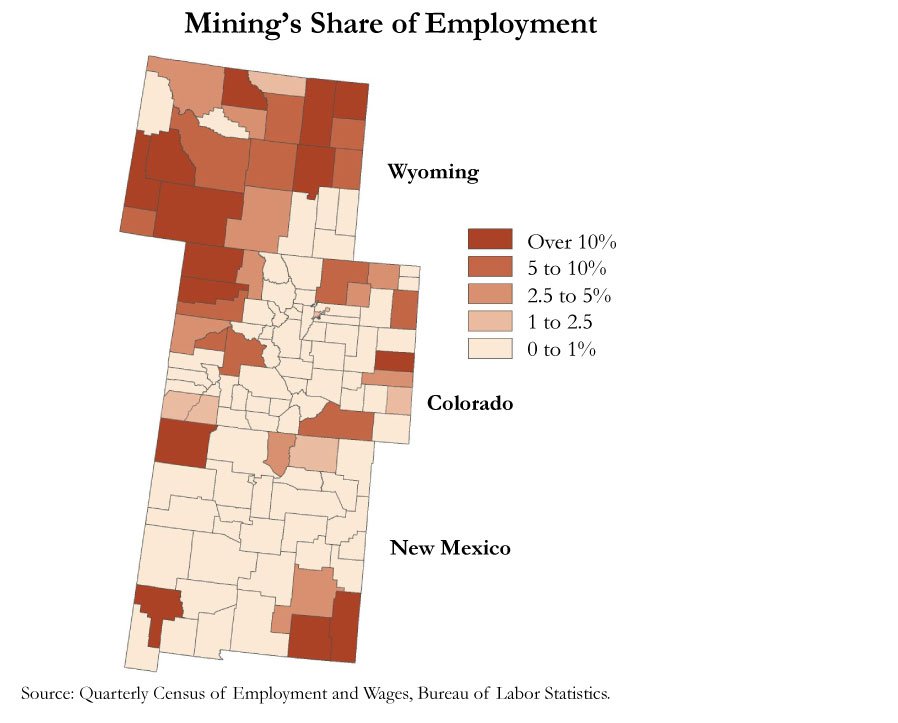
Workers in New Mexico’s energy sector in 2013 made up 3.4 percent of total state employment and contributed 5.9 percent of total earnings. More than 25 percent of workers in Lea and Eddy counties were employed in the energy sector in 2013, and San Juan and Grant counties employed more than 13 percent. Oil production in New Mexico increased 18.3 percent from 2012 to 2013, making up 3.7 percent of total U.S. oil production in 2013. Natural gas production has decreased slightly over the past decade in the state, but production in 2013 was ranked seventh at 4.7 percent of total U.S. production. New Mexico is also a producer of coal, ranking 12th in the nation.
Among the Mountain States, Wyoming is the most reliant on the energy industry. Energy sector employment in Wyoming in 2013 contributed 9.2 percent of total statewide employment and 18.4 percent of total personal earnings. Campbell, Sublette, Sweetwater and Converse counties all boasted energy sector employment of more than 20 percent of total employment. Oil and natural gas production contributed 2.3 and 7.2 percent, respectively, of total U.S. production in 2013, similar to the other Mountain States. In addition to being the third highest producing state of natural gas and seventh highest producing oil state, Wyoming is the largest producer of coal, bentonite, trona and uranium, and the second largest producer of rare earths.iii
In addition to the direct economic impact of the energy sector, there are also spillover effects through various channels. Many industries, such as manufacturing and transportation, supply goods and services directly to the energy sector. As the energy sector flourishes, it supports these ancillary industries and underlying employment opportunities. Furthermore, income earned within the energy sector gives individuals the means to buy homes and other goods and services, which boosts consumer spending and the local economy as a whole.
Looking Back: The Energy Sector over the Past 40 Years
The energy sector has shown much volatility over time. The supply, demand and ultimately the price of energy are determined by numerous factors ranging from the strength of global economies to geopolitics to technological advancement in drilling techniques. Over the past 40 years, one of the most dramatic fluctuations in oil prices occurred in the late 1970s and early 1980s (Chart 1).
Crude oil prices increased rapidly at the end of the 1970s and early 1980s due in part to the 1973 Organization of Petroleum Exporting Countries (OPEC) oil embargo of the United States, the Iranian revolution in 1979 and the Iran-Iraq war in 1980-81, all of which resulted in significant drops in the production and export of crude oil. Oil prices increased sharply in response to this drop in global oil supply. Global consumption of oil subsequently slowed as consumers curtailed their oil use due to higher prices and slower overall economic activity, as the United States witnessed two recessions between 1980 and 1982. This substantial longer-term demand response to the 1970s price increase began to put downward pressure on prices. Saudi Arabia attempted to maintain higher prices by slowing production, but this had little effect. In 1986, Saudi Arabia abandoned these efforts, causing the price of oil to collapse. Decreased demand and increased supply of oil led to a sharp decline in prices, which remained subdued for almost 20 years.iv
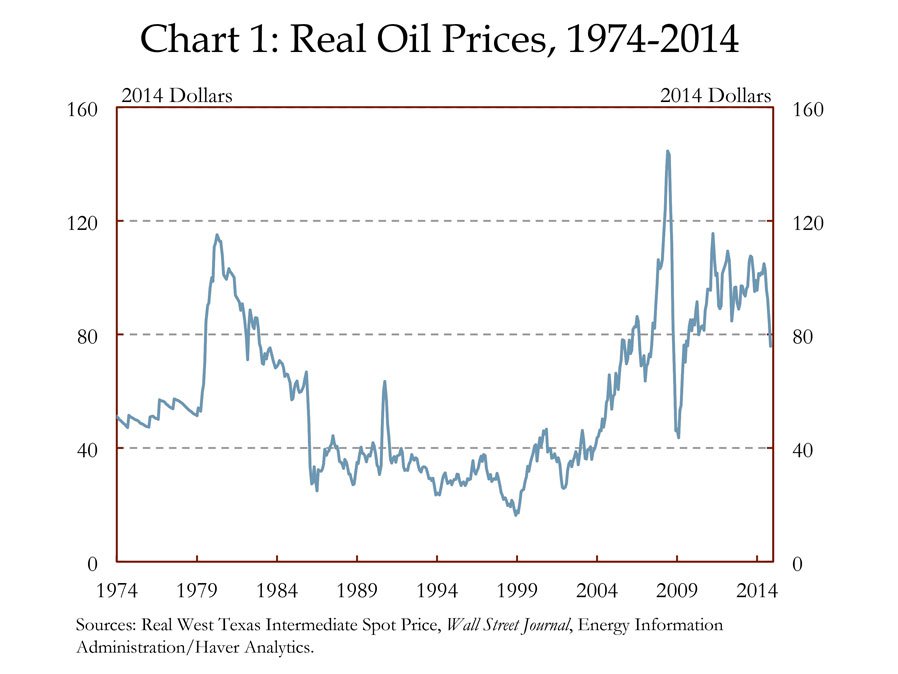
In response to years of decreasing energy prices and a weakening energy sector, states began to diversify away from the energy sector. However, as prices began to increase in the early 2000s, energy production increased and the Mountain States’ reliance on the energy sector picked up. By most measures, the energy sector makes up a smaller share of economic activity today than at its peak in the early 1980s. In 1981, the United States, Colorado, New Mexico and Wyoming all reached their respective peaks in energy’s share of GDP at 5.0, 6.1, 29.4 and 48.7 percent (Chart 2).
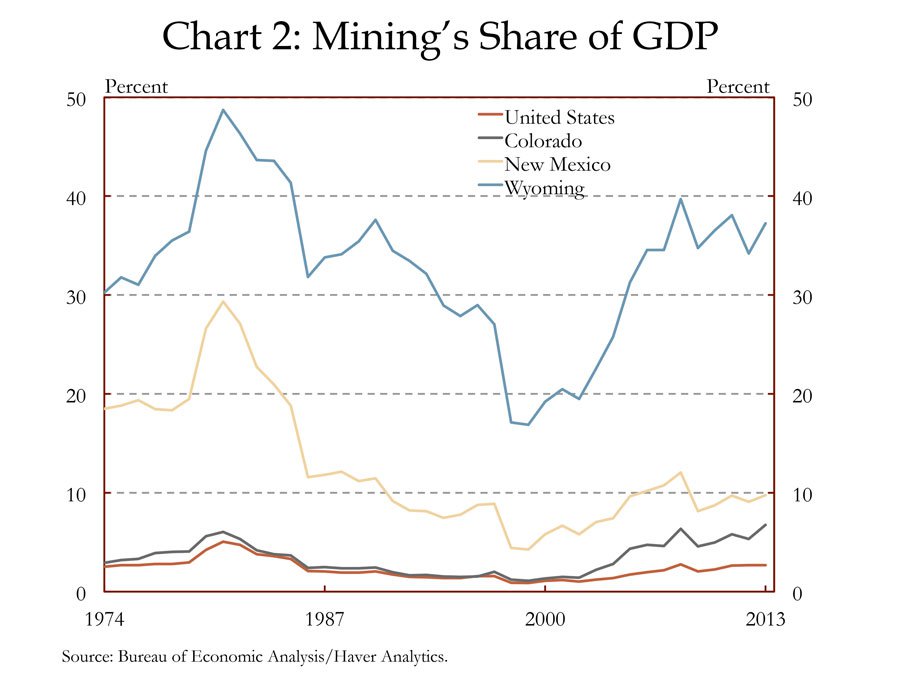
After reaching this peak, all regions began a steady decline that lasted until the late 1990s. However, despite the recessions beginning in 2001 and 2007, the energy sector has experienced recent strong growth. Energy’s share of GDP in Colorado reached 6.7 percent in 2013, surpassing its 1981 peak. Yet, the energy sector made up a smaller share of economic activity in 2013 than in the early 1980s in the United States, New Mexico and Wyoming, with the energy industry contributing 2.7 percent of U.S. GDP, 9.8 percent in New Mexico and 37.2 percent in Wyoming.
The share of employment and personal earnings attributed to the energy sector has followed a similar pattern (Charts 3 and 4). Energy’s share of employment and personal earnings reached their peaks in the early 1980s before beginning a 20-year decline. Among the Mountain States, Wyoming’s energy sector had both the highest share of total employment and earnings at its peak in the early 1980s at 14.5 and 25.2 percent, respectively. Although Wyoming has not returned to these previous peaks, energy’s shares in 2013 of total employment and total earnings have bounced back to 8.7 and 18.4 percent, respectively. Energy’s shares of employment and earnings in Colorado and New Mexico also remain below peak levels from the 1980s and are well below that of Wyoming. However, the energy sector plays a much larger role in Colorado, New Mexico and Wyoming than in the U.S.
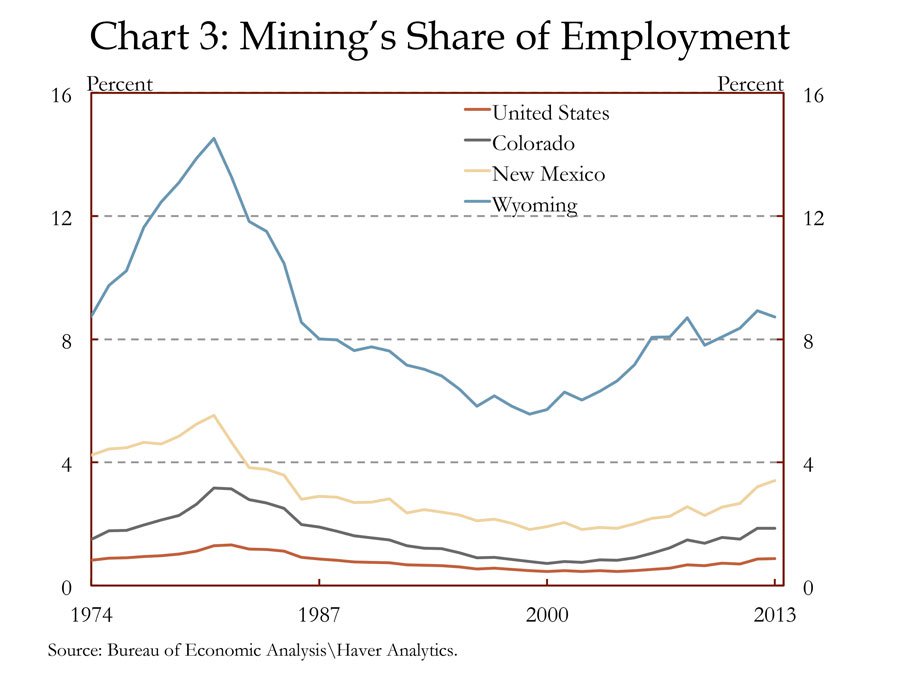
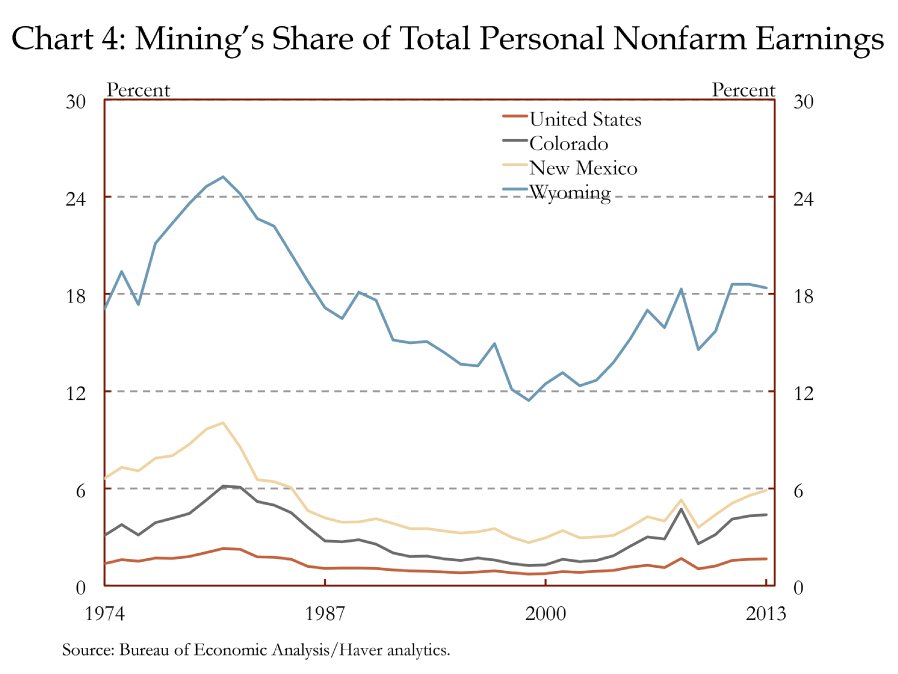
The Mountain States also rely heavily on the energy sector for severance tax collections. Similar to other energy sector indicators, severance tax revenues have fluctuated with overall mining and energy activity (Chart 5). Wyoming, which has the highest share of GDP, employment and earnings attributable to the energy sector, also has the highest share of severance tax revenue as a share of total state tax revenue, accounting for 52.8 percent in 1981 and 39.7 percent in 2013. Severance tax revenues at their peaks in 1982 reached 4.8 percent of total tax revenue in the United States, 30.8 percent in New Mexico and 2.9 percent in Colorado. In 2013, severance taxes remained below their 1982 peaks, with severance taxes making up less than 2 percent of total taxes in Colorado and in the U.S. and less than 14 percent in New Mexico.
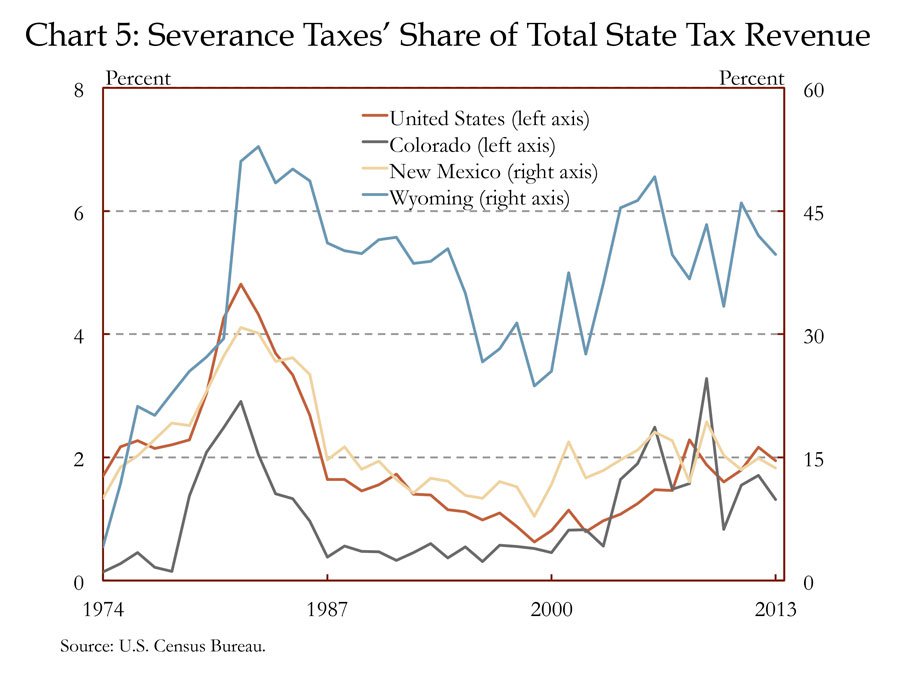
The recent resurgence of energy activity is most evident when looking at the rapid increase of energy production, specifically in crude oil and natural gas (Charts 6 and 7). Crude oil production in the last 10 years has experienced rapid growth in the Mountain States and the U.S. From September 2004 to September 2014, U.S. crude oil production grew 69 percent, reaching 273.3 million barrels per month, almost surpassing its February 1986 peak of 276.1 million barrels a month. The Mountain States also experienced rapid growth over the last decade, and, as of September 2014, New Mexico was producing 9.9 million barrels per month and Colorado and Wyoming each were producing more than 6 million barrels per month. Colorado has had the most notable growth in crude oil production, rising 263.6 percent from September 2004 to September 2014.
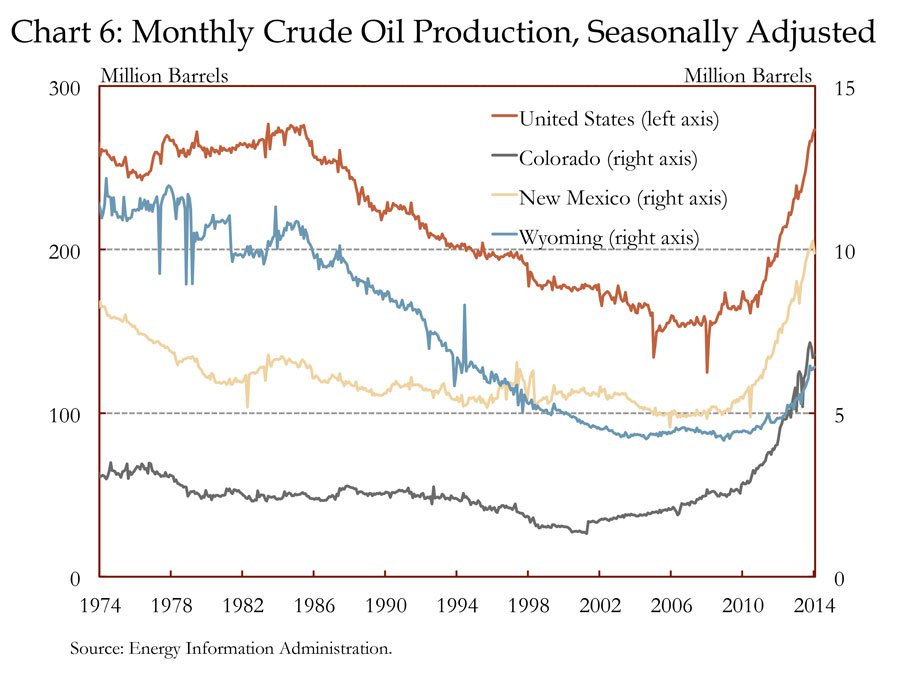
Expansion in natural gas production in Colorado and Wyoming started in the late 1980s and early 1990s, but then slowed around 2009. Similarly, New Mexico natural gas production increased in the late 1980s through about 1995 when production flattened and then decreased slightly moving into the 21st century. The U.S. followed a slightly different growth path than the Mountain States, with natural gas production remaining relatively flat until around 2005 when production began to increase, continuing this trend through 2014. New drilling techniques have led to increased national natural gas production, resulting in sustained lower prices over the last few years and slower production in the Mountain States relative to crude oil.
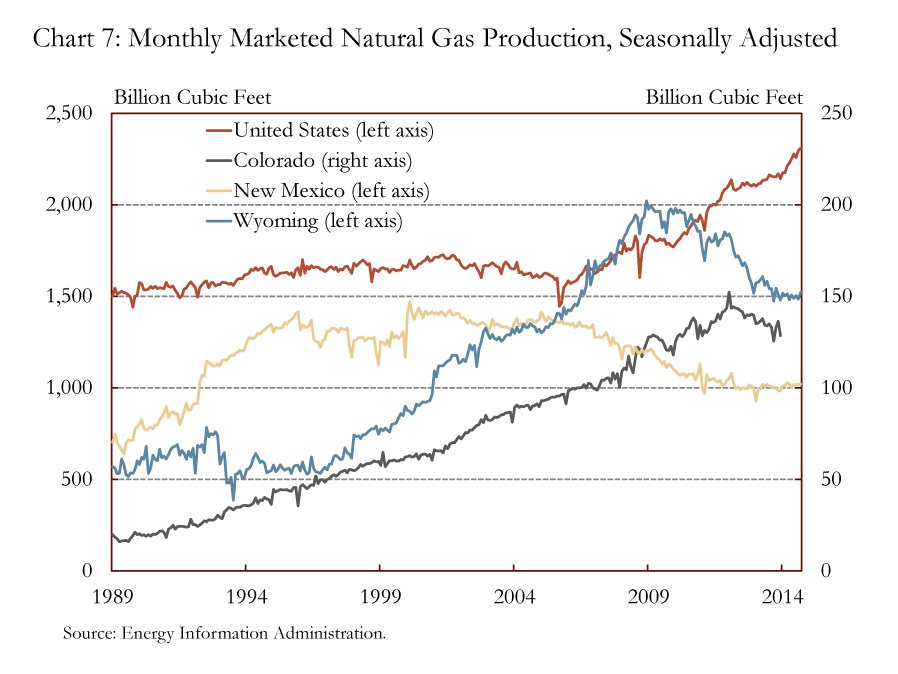
The energy sector has benefited from recent technological advancements, most notably hydraulic fracking, which has led to drilling of previously unobtainable or non-profitable underground reserves. Technological advancement has also led to productivity gains in the energy sector. Energy’s share of economic activity has been increasing in recent years and contributions from the Mountain States have helped make the U.S. one of the global leaders in energy production.
Conclusion
With the exception of mining’s share of GDP for Colorado, mining and energy activity makes up a smaller share of economic activity today than in the peak years of the early 1980s. However, energy remains an important sector in the Mountain States’ economies, directly contributing 10.6 percent of total GDP, 2.8 percent of total employment and 5.8 percent of total earnings when combining the economies of Colorado, New Mexico and Wyoming in 2013. Therefore, energy price volatility is likely to still have a significant impact on the Mountain States’ economies, with larger impacts for counties more heavily reliant on the energy sector.
End notes
i The terms “energy,” “energy and mining” and “mining” all refer to the “Mining, Quarrying, and Oil and Gas Extraction” (NAICS code 21) sector unless otherwise specified. The “Mining, Quarrying, and Oil and Gas Extraction” sector consists of the following subcategories: “Oil and Gas Extraction,” “Mining” and “Support Activities for Mining.” Furthermore, in 1997, the U.S. introduced the NAICS to replace the SIC as the primary industry classification system. Prior to 1998, the SIC category “Mining” (SIC codes 10-14) is used for GDP, employment and personal earnings. The SIC category “Mining” consists of the following subcategories: “Metal Mining,” “Bituminous Coal and Lignite Mining,” “Oil and Gas Extraction” and “Mining and Quarrying of Nonmetallic Minerals, except Fuels”.
ii Gross domestic product, employment and earnings data are from the Bureau of Economic Analysis; energy production data are from the Energy Information Administration.
iii "Wyoming Mining and Energy." Wyoming Business Council, n.d. Web.
iv Hamilton, James D., “Historical Oil Shocks” (February 2011). NBER Working Paper No. w16790.
v Gamal, Rania El. "Facing New Oil Glut, Saudis Avoid 1980s Mistakes to Halt Price Slide." Reuters. Thomson Reuters, Oct. 14, 2014. Web. Dec. 19, 2014.
